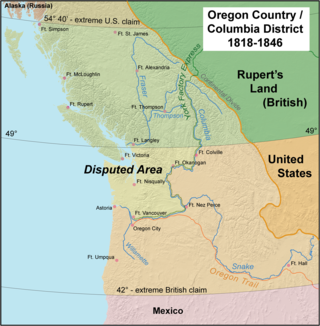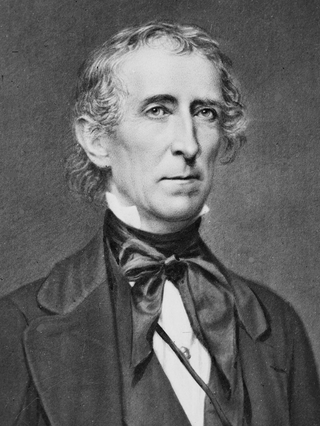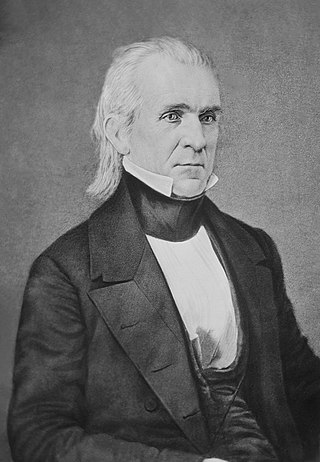Related Research Articles

James Knox Polk was the 11th president of the United States, serving from 1845 to 1849. A protégé of Andrew Jackson and a member of the Democratic Party, he was an advocate of Jacksonian democracy and extending the territory of the United States. Polk led the U.S. into the Mexican–American War, and after winning the war he annexed the Republic of Texas, the Oregon Territory, and the Mexican Cession.

The Republic of Texas, or simply Texas, was a breakaway state in North America. It existed for 10 years, from March 2, 1836 to February 19, 1846. It shared borders with Mexico, the Republic of the Rio Grande, and the United States of America.

The 1844 United States presidential election was the 15th quadrennial presidential election, held from Friday, November 1 to Wednesday, December 4, 1844. Democrat James K. Polk narrowly defeated Whig Henry Clay in a close contest turning on the controversial issues of slavery and the annexation of the Republic of Texas. This is the only election in which both major party nominees served as Speaker of the House at one point, and the first in which neither candidate held elective office at the time.

Samuel Houston was an American general and statesman who played a prominent role in the Texas Revolution. He served as the first and third president of the Republic of Texas and was one of the first two individuals to represent Texas in the United States Senate. He also served as the sixth governor of Tennessee and the seventh governor of Texas, the only individual to be elected governor of two different states in the United States.

George Mifflin Dallas was an American politician and diplomat who served as mayor of Philadelphia from 1828 to 1829, the 11th vice president of the United States from 1845 to 1849, and U.S. Minister to the United Kingdom from 1856 to 1861. Dallas was a son of U.S. Treasury Secretary Alexander J. Dallas, and studied law in his father's office and was admitted to the bar in 1813. He served as the private secretary to Albert Gallatin and worked for the Treasury Department and the Second Bank of the United States. He emerged as a leader of the Family Party faction of the Pennsylvania Democratic Party. Dallas developed a rivalry with James Buchanan, the leader of the Amalgamator faction. Between 1828 and 1835, he served as the mayor of Philadelphia, U.S. attorney for the U.S. District Court of Pennsylvania and as Pennsylvania's attorney general. He also represented Pennsylvania in the United States Senate from 1831 to 1833 but declined to seek re-election. President Martin Van Buren appointed Dallas to the post of Minister to Russia, and Dallas held that position from 1837 to 1839.

University Park is a city in Dallas County, Texas, United States, in suburban Dallas. The population was 25,278 at the 2020 census. The city is home to Southern Methodist University.

John Parker Hale was an American politician and lawyer from New Hampshire. He served in the United States House of Representatives from 1843 to 1845 and in the United States Senate from 1847 to 1853 and again from 1855 to 1865. He began his congressional career as a Democrat, but helped establish the anti-slavery Free Soil Party and eventually joined the Republican Party.

The Republic of Texas was annexed into the United States and admitted to the Union as the 28th state on December 29, 1845.

The Oregon boundary dispute or the Oregon Question was a 19th-century territorial dispute over the political division of the Pacific Northwest of North America between several nations that had competing territorial and commercial aspirations in the region.

Robert James Walker was an American lawyer, economist and politician. An active member of the Democratic Party, he served as a member of the U.S. Senate from Mississippi from 1835 until 1845, as Secretary of the Treasury from 1845 to 1849 during the administration of President James K. Polk, and briefly as Territorial Governor of Kansas in 1857. He was responsible for drafting the 1849 bill that eventually established the United States Department of the Interior.
This article traces the history of Dallas, Texas,.

John Neely Bryan was a Presbyterian farmer, lawyer, and tradesman in the United States and founder of the city of Dallas, Texas.
Bird's Fort was a community north of present-day Arlington, Texas (USA). In 1841, when John Neely Bryan established Dallas, he invited the settlers at Bird's Fort to come live in his proposed city.

The presidency of John Tyler began on April 4, 1841, when John Tyler became President of the United States upon the death of President William Henry Harrison, and ended on March 4, 1845. He had been Vice President of the United States for only 31 days when he assumed the presidency. The tenth United States president, he was the first to succeed to the office intra-term without being elected to it. To forestall constitutional uncertainty, Tyler took the presidential oath of office on April 6, assumed full presidential powers, and served out the balance of Harrison's four-year term, a precedent that would govern future extraordinary successions and eventually become codified in the Twenty-fifth Amendment. He was succeeded by James Polk of the Democratic Party.

The presidency of James K. Polk began on March 4, 1845, when James K. Polk was inaugurated as President of the United States, and ended on March 4, 1849. He was a Democrat, and assumed office after defeating Whig Henry Clay in the 1844 presidential election. Polk left office after one term, fulfilling a campaign pledge he made in 1844, and he was succeeded by Whig Zachary Taylor. A close ally of Andrew Jackson, Polk's presidency reflected his adherence to the ideals of Jacksonian democracy and manifest destiny.

John Tyler was the tenth president of the United States, serving from 1841 to 1845, after briefly holding office as the tenth vice president in 1841. He was elected vice president on the 1840 Whig ticket with President William Henry Harrison, succeeding to the presidency following Harrison's death 31 days after assuming office. Tyler was a stalwart supporter and advocate of states' rights, including regarding slavery, and he adopted nationalistic policies as president only when they did not infringe on the states' powers. His unexpected rise to the presidency posed a threat to the presidential ambitions of Henry Clay and other Whig politicians and left Tyler estranged from both of the nation's major political parties at the time.
Preston, also known as Preston Bend, is an unincorporated community and census-designated place located on the Red River in Grayson County, Texas, United States. It grew in the 19th century at the intersection of several military and trade roads and was an important crossing on the Shawnee cattle trail. Preston lost prominence after the MK&T railroad bypassed the town to the east, leading to a decline in traveler and cattle drive traffic. Much of its former town site is submerged beneath the waters of Lake Texoma. Its population was 2,096 as of the 2010 census.
John Alexander Greer was an American politician who served as the second lieutenant governor of Texas from 1847 to 1851 under Governors George T. Wood and Peter H. Bell. He was also the twelfth and final Secretary of Treasury of the Republic of Texas during Anson Jones' presidency. Greer County, Oklahoma, once claimed by Texas, is named in his honor.
Richard Franklin Bache, also known as Richard Bache Jr. (1784–1848), was a military and political official in the Republic and state of Texas. He assisted in drafting the Texas Constitution of 1845, the first of its five state constitutions.
In 1845, the Republic of Texas was annexed to the United States of America, becoming the 28th U.S. state. Border disputes between the new state and Mexico, which had never recognized Texas independence and still considered the area a renegade Mexican state, led to the Mexican–American War (1846–1848). When the war concluded, Mexico relinquished its claim on Texas, as well as other regions in what is now the southwestern United States. Texas' annexation as a state that tolerated slavery had caused tension in the United States among slave states and those that did not allow slavery. The tension was partially defused with the Compromise of 1850, in which Texas ceded some of its territory to the federal government to become non-slave-owning areas but gained El Paso.
References
- 1 2 3 4 Dallas Historical Society - Dallas History Archived 2006-04-22 at the Wayback Machine . Retrieved 20 April 2006.
- 1 2 DALLAS, TX from the Handbook of Texas Online. By Jackie McElhaney and Michael V. Hazel. Retrieved 20 April 2006
